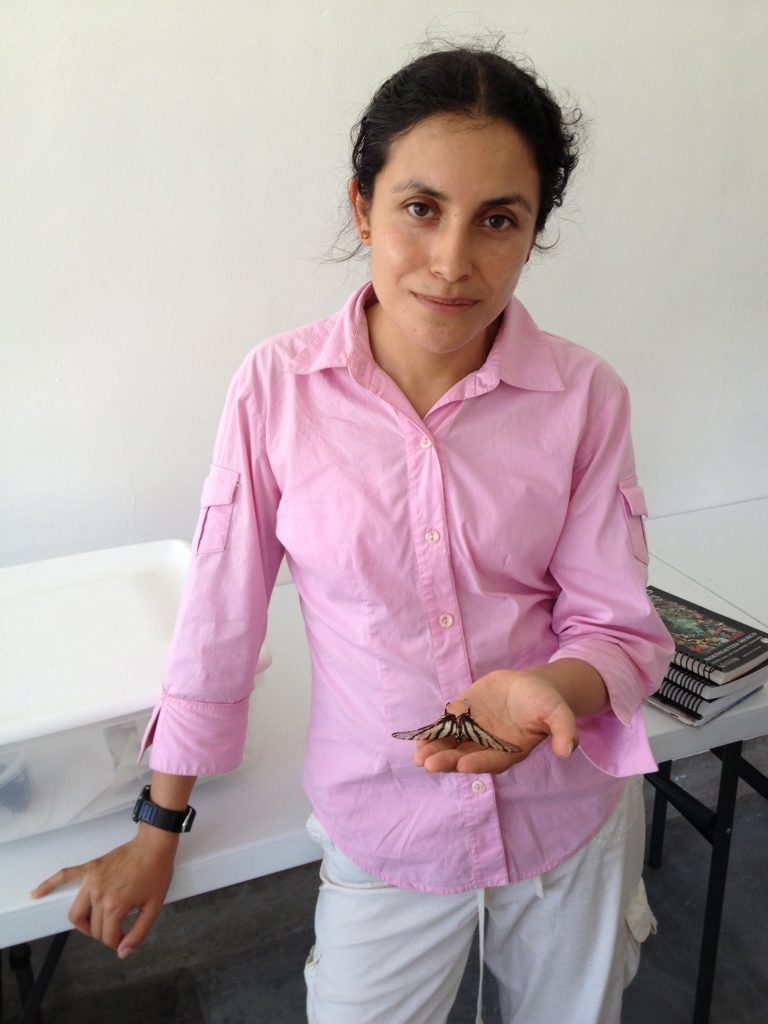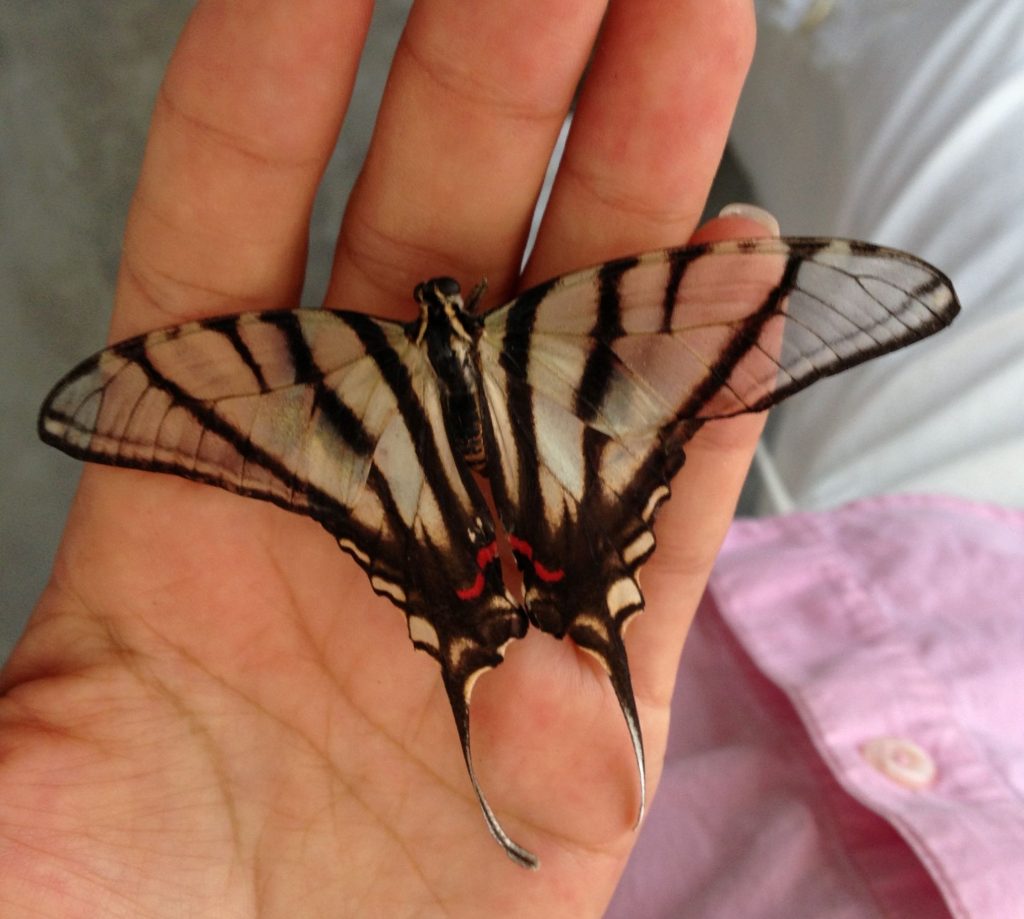I’m no life lister–not for birds, nor for butterflies. Checking species off a list doesn’t do it for me.
My interest lies in tromping through nature, observing, enjoying–and occasionally touching and photographing–the life cycle. The closer-up and more tactile the experience, the better. That’s just one reason I enjoy raising butterflies at home. You can witness the whole process, up close and in person.

Dainty Sulphur egg spotted along a beach trail in Huatulco, Oaxaca Mexico. Photo by Monika Maeckle
That said, it’s always special to see new creatures in all their iterations–a new stage of caterpillar whose butterfly form you’ve experienced in the garden or eggs discovered on the underside of a host plant. You have to look to find them. Once you do, there’s no turning back.

You have to look to find them: caterpillar stage of the One-spotted prepona spotted in the archaelogic park in Huatulco, Mexico. Photo by Monika Maeckle
One of the best ways to do that is to travel to new places and venture into the wilds. Another is to visit a flyhouse, or butterfly exhibit, at a natural history museum, zoo, nature park or freestanding. I had the opportunity to partake in both types of butterflying recently on a trip to Huatulco, Mexico, which seems to be angling to position itself as a butterflying and birding destination.

Yeé Lo Beé, under construction in La Jabalina just minutes from ecotourism resort in Huatulco, Mexico, aims to be the largest mariposario or butterfly house in Mexico. Photo by Monika Maeckle
Huatulco is a great place for butterflies. Oaxaca probably has the highest number of butterfly species in Mexico, according to butterfly expert and guide book author Kim Garwood, who has written two volumes on Central American and Mexican butterflies. With beach, jungle, lowland selva and mountains, every kind of habitat is available, said Kim. “When you have lots of different habitats and microhabitats, you have lots of plant diversity, which means lots of different butterfly species as well.”
Apart from the low jungle and high mountains of the Sierra Madre, Huatulco will soon offer one of the largest mariposarios, or butterfly houses, in Mexico. Yeé Lo Beé, which translates to “flower of heaven” in the Zapotec language of the native people of La Jabalina where the massive flyhouse is under construction, has been in development for two years and is scheduled to open in October.
Yeé Lo Beé biologist Ivonne Flores recently gave me, Kim Garwood and our Huatulco nature guide Cornelio Ramos Gabariel a tour of the the 75-acre site, almost a third of which will be devoted to a flyhouse, supporting plant nurseries, an “iguanario” or iguana exhibit, and other features. The ecopark will also feature a “butterfly liberation” area where visitors can release butterflies raised on the premises. Cost will likely run about $25 and the park will be geared to tourists and cruise ships who visit Huatulco for day trips.
Flores showed us the laboratory where the Yeé Lo Beé staff will produce all of the 1,000 butterflies that will occupy the 3000-square foot flyhouse each day with some 25 species of butterflies native to the Huatulco area. Flores oversees the lab as well as the three greenhouses where hundreds of host plants are tended by local people.

Yvonne Flores, staff biologist at Yeé Lo Beé in the lab with her favorite butterfly, the Kite-Swallowtail. Flores has been training locals to identify and help cultivate butterfly livestock for the mariposario. Photo by Monika Maeckle
Park developers have not enlisted outside expertise in planning or execution of the mariposario nor for securing its livestock, said Flores, choosing instead to grow their own. It’s relatively uncommon and extremely ambitious for such a large-scale project to produce its own livestock, especially with such a wide variety of species.

What a beauty! Flores shows off her favorite butterfly at Yeé lo Bée in Huatulco, Mexico. Photo by Monika Maeckle
“It’s not common,” said Nigel Venters, a longtime butterfly breeder and consultant to the butterfly breeding business based in Argentina. Venters has worked with flyhouses all over the world–from Saudi Arabia and England to Costa Rica and New York. “There are very few flyhouses that raise a big percentage of what they display. This is not easy and takes many years of experience.”
We applaud the effort and look forward to visiting again once it’s open.
According to the institutional video, Yeé Lo Beé is founded “by a group of people passionate about the responsible use of nature.” Founder and Mexican impresario Genaro Gomez categorized the massive project as “Not a personal project. It’s a project of Huatulqueños, and all the people that work in Huatulco.”

A Julia butterfly at Llano Grande Mariposario or “Butterfly Camp” near Huatulco, Mexico. Photo by Susan Ford-Hoffert
Another mariposario, less ambitious and further from the main tourist center, lies about an hour away. Llano Grande, a project of the Zapotec community, offers a modest butterfly house with a handful of species in their various stages. School groups, locals and adventurous tourists mingle along the circular path inside, as a local cook whips up fajitas and elotes (grilled corn) in a large palapa.
The destination sits on the banks of the LLano Grande river (no relation to our own Llano River in the Texas Hill Country) and offers a lovely waterfall for bathing as well as an enormous food palapa and event area. A souvenir stand and swimming area beckon and a plant nursery operates seasonally, offering plants used in traditional medicine. Llano Grande offers a different, more local experience than you’ll expect at the grand Yeé lo Beé. Cost to enter is about $3.
Each of these adventures presents different charms. Add a butterflying trip to the jungle and mountains and your Mexican butterfly adventure will be complete.
More stories like this:
Like what you’re reading? Follow butterfly and native plant news at the Texas Butterfly Ranch. Sign up for email delivery in the righthand navigation bar of this page, like us on Facebook, or follow us on Twitter, @monikam.
- Blue Morphos and a Butterfly Bonanza in Huatulco, Mexico
- Alamo, Texas: A great base for birds, bugs and butterflies
- Black Witch Moth: Large, Batlike and Harmless
- Loathed by Gardeners: the Tomato Hornworm Morphs into the Magnificent Sphinx Moth
- Jimsonweed Hosts the Magnificent Sphinx Moth
- Tropical Milkweed: To Plant it or Not, It’s not a Simple Question

I will sure come on VAC. an see your BUTTERFLY HOUSE IN OCT. have been waiting to here of one . Thank you for doing this type of thing. Can’t wait!!!!! CHRISTINE from ARKANSAS
Gorgeous plants and images of butterflies. Carry on with your great vision. Have you any hummingbirds in that area? They can also be a great source of beauty.
Peter
Admirer of all things both mechanical, musical and lifelike.
Yes , We do have a lot of Hummingbirds in ARKANSAS.
Very nice yee lo bee
Wonderful article. I just kept saying WOW! WOW! WOW! That would be so neat. Keep us updated on your progress. This project is so exciting! I share your love of butterflies. People always laugh at me because I will be giving instructions or talking and all of a sudden I’ll look up and say ‘Oh, a butterfly!’.
Wish I could come to help you.